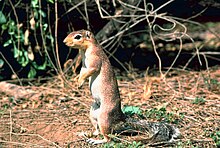Xerini
 From Wikipedia the free encyclopedia
From Wikipedia the free encyclopedia
| Xerini Temporal range: Early Oligocene - Recent | |
|---|---|
 | |
| Unstriped ground squirrel (Xerus rutilus) | |
| Scientific classification | |
| Domain: | Eukaryota |
| Kingdom: | Animalia |
| Phylum: | Chordata |
| Class: | Mammalia |
| Order: | Rodentia |
| Family: | Sciuridae |
| Subfamily: | Xerinae |
| Tribe: | Xerini Osborn, 1910 |
| Genera | |
Xerini is a tribe of ground squirrels occurring in Africa and Asia. With the tribes Marmotini (Holarctic ground squirrels) and Protoxerini (African tree squirrels), they form the subfamily Xerinae. There are five living genera—Xerus, the unstriped ground squirrel; Euxerus, the striped ground squirrel; Geosciurus, the Cape and mountain ground squirrels; Atlantoxerus, containing the living Barbary ground squirrel of North Africa and some extinct species; and Spermophilopsis, containing the long-clawed ground squirrel of Central Asia.
The squirrels live in open woodlands, grasslands, or rocky country. They are diurnal and terrestrial, living in burrows. Their diet is roots, seeds, fruits, pods, grains, insects, small vertebrates and bird eggs. They live in colonies similar to North American prairie dogs, and have similar behavior. If kept as pets, they run free as house cats do, otherwise farmers consider them pests. Breeding in South African ground squirrels is asynchronous and there is no specific period of breeding although very few litters are seen above the ground in the months of July to October. Gestation period lasts for 48 days and the young ones are weaned after 52 days. There are one to three babies per litter. A female becomes sexually mature when she is 10 months old and a male matures at the age of 8 months. Although a female has the capability to breed throughout the year, less than 10% reproduce more than one litter in a year.
The South African ground squirrel does not hibernate. These squirrels are very social and live in groups with about 1 to 3 females and 2 to 3 males. Sometimes, the number of males can exceed up to 9 with some sub-adult females. An interesting thing about this breed is that mature males like to form their own groups and there can be 19 to 20 individuals in one group. These groups are called bands.
Their home range is shared with other groups which is actually quite a surprising thing, since in case of most of the mammals there is generally an extremely tough competition to get the female. The group-living instinct of this species gives it a survival opportunity from predators overweighing the disadvantage of breeding opportunities which come from competition.
Species[edit]
Extant species
- Genus Atlantoxerus
- Barbary ground squirrel, Atlantoxerus getulus
- Genus Euxerus
- Striped ground squirrel, Euxerus erythropus
- Genus Geosciurus
- Cape ground squirrel, Geosciurus inauris
- Mountain ground squirrel, Geosciurus princeps
- Genus Xerus
- Unstriped ground squirrel, Xerus rutilus
- Genus Spermophilopsis
- Long-clawed ground squirrel, Spermophilopsis leptodactylus
Fossil species
- Genus Heteroxerus
- Genus Aragoxerus
References[edit]
- Thorington, R.W. Jr. and Hoffmann, R.S. 2005. Family Sciuridae. Pp. 754–818 in Wilson, D.E. and Reeder, D.M. (eds.). Mammal Species of the World: a taxonomic and geographic reference. 3rd ed. Baltimore: The Johns Hopkins University Press, 2 vols., 2142 pp. ISBN 978-0-8018-8221-0